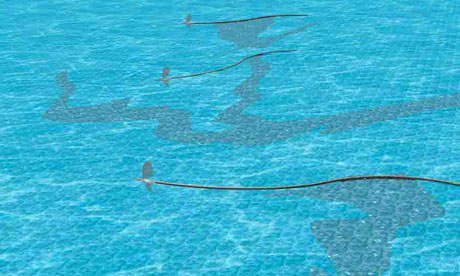
For big problems, you need big ideas, even if they seem crazily ambitious. And with the anniversary of the BP Deepwater Horizon oil spillon 20 April, a swarm of robot oil-slick clearing boats is a timely big idea.
The concept of the sailing drone is being developed by a project calledProtei, which is notable in that all the technology and software is open source - no patents, no copyright. So, if it works, anyone can use it.
The idea, explained to me by project co-ordinator Cesar Harada, is as follows. In marine oil spills, the oil is blown downwind, so boats designed to sail upwind while dragging absorbent booms behind can soak up the oil. As the boats have no crew, no-one's health is endangered by oil or dispersants and the boats can go out in all weather (they are designed to be self-righting - a "torpedo with a sail", says Harada).
"There are oil spills all the time," Harada says when I ask him why he started the project, for example in the Niger delta. "And using the same natural force that is pushing the oil to clean it up makes sense."
But sailing upwind, dragging a large load, is not easy. So the team have developed a hull that flexes like the backbone of a fish, which they say make sailing upwind easier. Harada, now based in New Orleans, is ex-MIT and a TED fellow and many of the team are based in academic engineering departments.
They have tested six small scale prototypes - see the video below - but aim to launch a full scale boat, 8m long with a 20m boom-tail, from Rotterdam in September. "We know the idea works, but not how well it works," says Harada. Protei have raised enough to keep the project afloat for a while, but are seeking more, in particular for sensors to monitor the tests.
The drones would be deployed in swarms, which would avoid each other either by using a decentralised swarm algorithm or by being controlled remotely from the shore. "Since I got to New Orleans, we have really changed the project so that local fishermen will be able to build and control the boats," says Harada. "When I first came they told me I was crazy and would steal all their jobs with an robot sailing boat."
Harada also sees long term applications of the sailing drones in clearing up the plastic and other pollutants concentrated in the great Pacific garbage patch and in towing scientific payloads around the oceans.
The nearest existing equivalent appears to be the patented Waveglider, which uses wave power to travel the oceans. But they are slow, claims Harada, doing about 2 knots. He says Protei's sailing drones will be much cheaper and faster.
Of course, we've also had Kevin Costner's centrifuge-based oil clean up technology. That is also patented and does not appear to have been deployed in a major operation yet.
So, Protei seems to me to be useful, simple and backed by smart people. Crucially, by virtue of being open source, the profit motive can't compromise the search for the best technical solution. But I'd be keen to hear what you all think, especially if you have knowledge of relevant areas.
We seriously need a new technology to recover from oil spills.We have seen many oil spill disasters which are taken place in Offshore sector.We have seen that there is drastic decrease of oil spills in Baltic sea 2013 and 2014.New innovative oil spill recovery technologies are going to take place to reduce the oil spills and also separation oil from water.Let's see what happens....
ReplyDelete